


By Charly D. Miller,
Paramedic EMS Author & Educator,
Consultant Restraint Asphyxia Expert Witness
Updated (finally!) in SEPTEMBER, 2004

The original “webpage” versions of “RASK” Parts 1 & 2 remain posted on this website.
However, in December, 2005, I created and posted a PDF file containing
BOTH Parts 1 & 2 of RASK, and
the REFERENCES for all the RASK article parts!
If you’re going to PRINT these parts, I strongly suggest you print their PDF file:
Restraint Asphyxia – Silent Killer Parts 1 & 2 and References

INFORMATION Related to TERMS Used Within This Article:
(If this is your first “trip” here, it is important that you read this section before reading the article.
On subsequent trips you can Click HERE to skip to the article.)
GENDER TERMINOLOGY:
Although I am a woman, it is easier to use male pronouns (“he,” “him,” and so on) than writing “she/he,” “her/him,” and the like. So, that’s what I’ve done.
MEDICAL TERMINOLOGY:
Because people with little-to-no medical education require this information just as much as medical professionals, I have minimized use of medical terms and explained concepts as simply as possible. Any reader who is offended by the simplicity of my explanations, can go play in my RESTRAINT ASPHYXIA LIBRARY.
Within this article, the term, “VICTIM” means:
a “patient,” “client,” “consumer,” “suspect,” “subject,” “criminal,” “inmate,” “student,” or the like!
 I’ve used the term, VICTIM, because – without fail – ALL individuals who have ever died due to restraint asphyxia were “Victims” of some form of problem that caused them to involuntarily suffer some form of “ALTERED LEVEL OF CONSCIOUSNESS” that ultimately caused them to require application of restraint.
I’ve used the term, VICTIM, because – without fail – ALL individuals who have ever died due to restraint asphyxia were “Victims” of some form of problem that caused them to involuntarily suffer some form of “ALTERED LEVEL OF CONSCIOUSNESS” that ultimately caused them to require application of restraint.
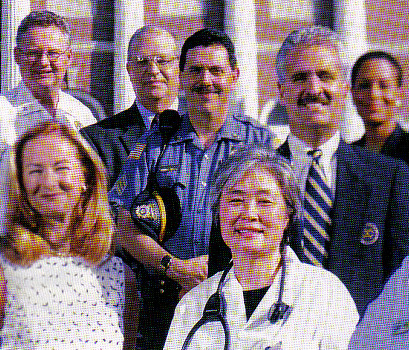 |
 |
or “RESTRAINER” refer to ANY PERSON who’s job description includes the responsibility of responding to, and possibly restraining, ANY individual experiencing an “emergency” that requires restraint.  And, any RESPONDER who is responsible for ensuring the care and safety of a “patient,” “client,” “consumer,” “suspect,” “subject,” “criminal,” “inmate,” or the like, becomes a RESTRAINER when they begin to apply restraint. And, any RESPONDER who is responsible for ensuring the care and safety of a “patient,” “client,” “consumer,” “suspect,” “subject,” “criminal,” “inmate,” or the like, becomes a RESTRAINER when they begin to apply restraint. In other words: RESPONDERS and RESTRAINERS are Emergency Medical Services (EMS) or Fire Department personnel; Law Enforcement Officers or Correctional Facility personnel; Emergency Department (ED) personnel; General-Hospital or Psychiatric Facility personnel; OR they are Staff members of Homes, Schools, Vocational Training, or other Facilities established for the care and supervision of mentally ill or developmentally-disabled individuals – AND THE LIKE! In other words: RESPONDERS and RESTRAINERS are Emergency Medical Services (EMS) or Fire Department personnel; Law Enforcement Officers or Correctional Facility personnel; Emergency Department (ED) personnel; General-Hospital or Psychiatric Facility personnel; OR they are Staff members of Homes, Schools, Vocational Training, or other Facilities established for the care and supervision of mentally ill or developmentally-disabled individuals – AND THE LIKE! |
“PHYSICAL” Restraint is defined as one or more human beings applying their HANDS (and other of their BODY PARTS) to an individual’s body, for the purpose of preventing that individual’s freedom of movement.
  
|
 |
 In the past, the term “MECHANICAL Restraint” was most often used only when referring to METAL restraint devices – handcuffs, ankle “shackles, ” and the like. However, any DEVICE used for restraint (be it metal, or a roll of gauze, a sheet, a plastic or Velcro® strap, a leather or fabric cuff/strap, or the like) is, technically, a “mechanical” restraint. In the past, the term “MECHANICAL Restraint” was most often used only when referring to METAL restraint devices – handcuffs, ankle “shackles, ” and the like. However, any DEVICE used for restraint (be it metal, or a roll of gauze, a sheet, a plastic or Velcro® strap, a leather or fabric cuff/strap, or the like) is, technically, a “mechanical” restraint. |
 |

|
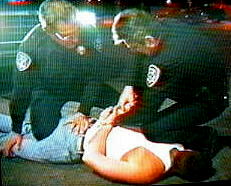 Photo © 1997 BioguardianSystems,Inc |
 |
FORCEFUL-PRONE-RESTRAINT” |
FORCEFUL-PRONE-RESTRAINT” |
 |
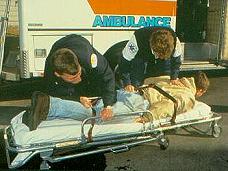 Photo © 1997 Howard M. Paul |
Clearly, “PHYSICAL” and “MECHANICAL” forms of FORCEFUL-PRONE-RESTRAINT are relatively the same thing: Application of FORCE to an individual’s body while he is in a PRONE position, and preventing his movement out of the forcefully-prone-restrained position.
Hence, within this article, “FORCEFUL-PRONE-RESTRAINT” refers to EITHER
physical or mechanical means of forcefully maintaining someone in a prone-restraint position.
 Photo © 1997 Howard M. Paul |
 |
 |
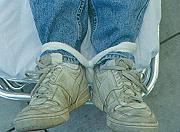 Photo © 1994 Michal Heron |
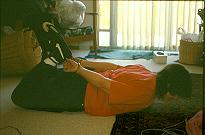 Photo © 1997 Howard M. Paul |
 |
|
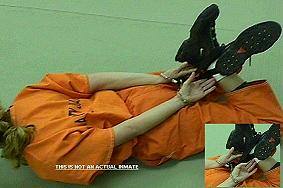 Photo Source = ? |
“POSITIONAL ASPHYXIA”
is most simply defined as death that occurs because the POSITION of a person’s body interferes with respiration (breathing), and the person cannot get OUT of that position. Death occurs due to the person’s inability to BREATHE anymore.
 ANY body position that obstructs the AIRWAY, OR that interferes with the muscular or MECHANICAL MEANS of getting air into and out of the body (the body’s “BELLOWS” function) will result in a positional asphyxia death, if the person cannot get out of it.
ANY body position that obstructs the AIRWAY, OR that interferes with the muscular or MECHANICAL MEANS of getting air into and out of the body (the body’s “BELLOWS” function) will result in a positional asphyxia death, if the person cannot get out of it.
is a form of POSITIONAL ASPHYXIA death.  The factor that distinguishes a “restraint asphyxia” death from a “positional asphyxia” death, is that some form of RESTRAINT is the reason the Victim couldn’t ESCAPE the asphyxiating position. The factor that distinguishes a “restraint asphyxia” death from a “positional asphyxia” death, is that some form of RESTRAINT is the reason the Victim couldn’t ESCAPE the asphyxiating position. First proposed in 1993, the phrase “Restraint Asphyxia” has become more widely-adopted since 1998.(1,2) Yet, several other phrases continue to be used when referring to incidents of restraint asphyxia: “Mechanical Asphyxiation,” “Traumatic Asphyxiation,” “Sudden In-Custody Death,” and the like. First proposed in 1993, the phrase “Restraint Asphyxia” has become more widely-adopted since 1998.(1,2) Yet, several other phrases continue to be used when referring to incidents of restraint asphyxia: “Mechanical Asphyxiation,” “Traumatic Asphyxiation,” “Sudden In-Custody Death,” and the like. |
 |
 2004 PPt Slide, C.D.Miller |
 Since 1994, however, leading medical examiners and forensic pathologists officially recognized restraint-related forms of positional asphyxia as being quite different. Restraint asphyxia deaths are due to PEOPLE having acted to physically or mechanically entrap someone.(3-5) Thus, the “manner” of death for the majority of restraint asphyxia deaths is now recognized as “HOMICIDE.”
Since 1994, however, leading medical examiners and forensic pathologists officially recognized restraint-related forms of positional asphyxia as being quite different. Restraint asphyxia deaths are due to PEOPLE having acted to physically or mechanically entrap someone.(3-5) Thus, the “manner” of death for the majority of restraint asphyxia deaths is now recognized as “HOMICIDE.”
Responders sometimes encounter excited or agitated individuals who act-out in physically-exertional, violent and dangerous manners. To ensure Victim AND Responder safety – and to facilitate thorough medical evaluation and care of the Victim – violently-exertive, excited or agitated individuals MUST be RESTRAINED.
However, just as “choking” someone into unconscious submission is NOT appropriate, restraining a violently-exertive, excited or agitated individual in any OTHER manner that prevents them from being able to BREATHE is ALSO, emphatically, NOT appropriate!
The physical or mechanical restraint of an individual is always a “last resort.” The “least-restrictive” means of restraint (or use of force) – such as verbal counsel and de-escalation techniques – should always be employed before Responders resort to using hands-on or mechanical restraint.(6-8)
Any form of restraint that interferes with someone’s AIRWAY,
CHOKE HOLDS can cause death in two different ways:
No one argues about the fact that choking can cause death due to
In other words: No matter how “carefully” any
Because choke holds have rightly been banned from use for many years,
Alternative methods of restraint are available to every Responder;
Only if ALL of the above THREE ELEMENTS are discovered during an accurate and effective autopsy investigation, can an individual’s cause of death be identified as a form of
“POSITIONAL ASPHYXIA” – whether due to restraint asphyxia, or not.
An Effectively Functioning Muscular Pump or “Bellows System”
NEXT: Normal breathing requires both effective inspiration and expiration; the movement of air in and out of the body. But, air will ONLY move from one place to another – from the atmosphere into the lungs, or from the lungs back out to the atmosphere – if the air pressure in one of those two places has been CHANGED.
When the internal lung-space size is increased, the air pressure inside the lungs becomes “stretched,” decreasing the internal air pressure, and creating a “negative intrathoracic air pressure” (relative to atmospheric air pressure). In other words, increasing the space and size of the lungs creates a “vacuum” within the lungs.
Reducing the interior lung-space size causes “compaction” of the internal air pressure, increasing the internal air pressure, and creating a “positive intrathoracic air pressure” (relative to atmospheric air pressure). When the airway opens, air moves out of the lungs (now an area of higher pressure than that of the atmosphere), producing EXPIRATION.
When breathing becomes difficult (for whatever reason), “accessory” muscles are automatically employed to assist the intercostal muscles and diaphragm in creating the lung-space-size changes (the air pressure changes) required for inspiration and expiration to occur.(11,19)
Restraint asphyxia researchers have been warning Restrainers against the use of prone-hogtie and forceful-prone-restraint since the late 1980’s.(1,3,11,12,16,17,20) In recent years, however, restraint asphyxia researchers have come to the relatively-universal agreement that, restraint – by itself – is not solely responsible for asphyxia that occurs while a Victim is being actively restrained by others.(1,4,5,12,17,18,21-25)
PART TWO of this article
About the Author: Charly is an internationally-known emergency care author, EMS Instructor, Consultant, and Restraint Asphyxia Expert Witness.
A paramedic since 1985 (nine years as a “Denver General” Paramedic), Charly is a seasoned prehospital emergency care provider. With her additional experience as a psychiatric medical technician and an Army National Guard helicopter medic, Charly is one of the country’s most exciting and entertaining EMS educators.


 Unfortunately, verbal restraint techniques are entirely ineffective when someone has become (due to any of a myriad of causes) the Victim of an ALTERED LEVEL OF CONSCIOUSNESS. Someone with an altered level of consciousness does not have the mental ability to comprehend verbal counsel or de-escalation techniques. Thus, some form of restraint application is REQUIRED to ensure the safety of the Victim and all around him.
Unfortunately, verbal restraint techniques are entirely ineffective when someone has become (due to any of a myriad of causes) the Victim of an ALTERED LEVEL OF CONSCIOUSNESS. Someone with an altered level of consciousness does not have the mental ability to comprehend verbal counsel or de-escalation techniques. Thus, some form of restraint application is REQUIRED to ensure the safety of the Victim and all around him.
 HOWEVER. Even when restraint is REQUIRED, only the “least restrictive” means may be employed.(6-8) In other words: only the minimum amount of force or restraint necessary to ensure everyone’s “SAFETY” (and to afford thorough medical evaluation and treatment of the Victim) may be used. And, the SAFETY of both Restrainers and Victim must be ensured during the initiation, employment, and maintenance of ANY form of restraint.
HOWEVER. Even when restraint is REQUIRED, only the “least restrictive” means may be employed.(6-8) In other words: only the minimum amount of force or restraint necessary to ensure everyone’s “SAFETY” (and to afford thorough medical evaluation and treatment of the Victim) may be used. And, the SAFETY of both Restrainers and Victim must be ensured during the initiation, employment, and maintenance of ANY form of restraint.
or that interferes with someone’s MECHANICAL means of breathing,
can KILL the restrained Victim.
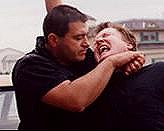


Photo © 2003 JEMS
“Tactical Neck Holds” … “Lateral Vascular Neck Restraints” … and the like)
have rightly been BANNED from use by many emergency services.
1. Death due to Airway Obstruction OR
2. Death due to “CAROTID ARTERY COMPRESSION.”(2,9)
Airway Obstruction.
 But, anyone who promotes the idea that even a “carefully” applied form
But, anyone who promotes the idea that even a “carefully” applied form
of choke hold can “SAFELY” be employed (by avoiding obstruction of
the Victim’s AIRWAY) is obviously entirely uneducated about the OTHER,
equally-lethal, choke hold effects caused by Carotid Artery Compression.(10)
 Carotid Artery Compression can cause stroke or death
Carotid Artery Compression can cause stroke or death
due to obstruction of blood-flow to the brain – or by dislodging
a plaque embolus (a clump of the “crud” that builds up along the lining
of some people’s arteries), and sending it to obstruct an artery in the brain).
 OR Carotid Artery Compression can cause death due to
OR Carotid Artery Compression can cause death due to
“CAROTID-SINUS-STIMULATION”.
 Stimulation from pressure placed on one or both carotid arteries
Stimulation from pressure placed on one or both carotid arteries
triggers a lethally SLOW heart-rate – in fact, it can actually
STOP the heart from beating.(2)
A Restrainer thinking to avoid compressing the
airway by using the “crook” of his arm to “cradle”
the violently-struggling Victim’s neck actually
may increase the likelihood that
CAROTID ARTERY OBSTRUCTION
or STIMULATION will occur.
form of “CHOKE HOLD” is employed, any Victim
subjected to a choke hold can rapidly DIE!
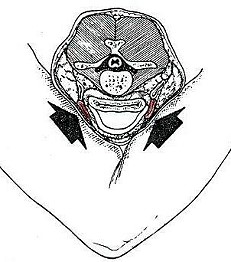

Restraint Asphyxia is most often caused by
“Forceful-Prone-Restraint” application.
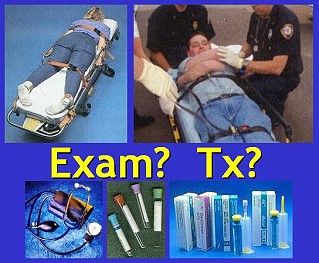
2004 PPt Slide, C.D.Miller
medical examination and care provision,
forceful-prone-restraint application
(with or without the simultaneous
application of any kind of “hogtie” restraint)
has been recognized as being a cause of
restraint asphyxia deaths since 1988(11),
and its use has long been
CONTRAINDICATED
by knowledgeable professionals.
Furthermore, if access for thorough medical examination and care provision is not a “concern,”
SAFE methods of employing PRONE restraint ARE possible.
to be SAFE and EFFECTIVE is
EFFECTIVE (in-depth) EDUCATION,
practice, and team work.
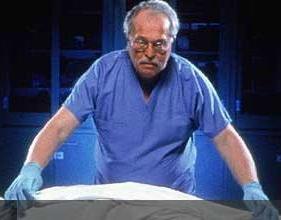

to pronounce someone dead due to
“POSITIONAL ASPHYXIA”
(whether or not the positional asphyxia
death is restraint-related),
ALL of the following THREE key elements
MUST BE SUBSTANTIATED
during an AUTOPSY INVESTIGATION:(2,12-15)
 In fact, it is only when there is no clearly apparent “cause of death” found at autopsy that a medical examiner is prompted (required) to more-closely examine the activities and events surrounding the actual TIME OF DEATH, in order to determine the factual CAUSE of death.(2,16-18)
In fact, it is only when there is no clearly apparent “cause of death” found at autopsy that a medical examiner is prompted (required) to more-closely examine the activities and events surrounding the actual TIME OF DEATH, in order to determine the factual CAUSE of death.(2,16-18)
 BTW: The “Time Of Death” position that the medical examiner must investigate is the position the Victim was in at the moment when his breathing or pulse was FIRST noticed to have stopped – NOT the position the Victim was in at the time that all prehospital and/or inhospital resuscitation efforts were determined to have failed, and he was “PRONOUNCED” dead.
BTW: The “Time Of Death” position that the medical examiner must investigate is the position the Victim was in at the moment when his breathing or pulse was FIRST noticed to have stopped – NOT the position the Victim was in at the time that all prehospital and/or inhospital resuscitation efforts were determined to have failed, and he was “PRONOUNCED” dead.
 “ASPHYXIATING” POSITIONS RANGE FROM
“ASPHYXIATING” POSITIONS RANGE FROM
so as to obstruct the trachea (the largest “lower airway” passage); or
a position that impedes or prevents the MECHANICAL means of breathing;
 Clinical asphyxia studies have shown that airway obstruction causes a variable period of physically-forceful muscular hyperactivity and reposition attempts, while the CONSCIOUS Victim struggles to alleviate or escape the position that is interfering with his breathing. If the victim is unable to regain the ability to breathe, he rapidly becomes UNCONSCIOUS.
Clinical asphyxia studies have shown that airway obstruction causes a variable period of physically-forceful muscular hyperactivity and reposition attempts, while the CONSCIOUS Victim struggles to alleviate or escape the position that is interfering with his breathing. If the victim is unable to regain the ability to breathe, he rapidly becomes UNCONSCIOUS.
 Once UNCONSCIOUSNESS ensues, a portion of the Victim’s brain INVOLUNTARY cues his body to continue performing muscular activity, in an unconscious effort to alleviate or escape the position that is interfering with breathing. Thus, the Victim’s muscular “struggle” does not stop even after loss of consciousness occurs. In fact, struggle to alleviate or escape the position that is interfering with breathing does not STOP until after the Victim’s PULSE STOPS!(19)
Once UNCONSCIOUSNESS ensues, a portion of the Victim’s brain INVOLUNTARY cues his body to continue performing muscular activity, in an unconscious effort to alleviate or escape the position that is interfering with breathing. Thus, the Victim’s muscular “struggle” does not stop even after loss of consciousness occurs. In fact, struggle to alleviate or escape the position that is interfering with breathing does not STOP until after the Victim’s PULSE STOPS!(19)
 In positional asphyxia deaths unrelated to RESTRAINT, alcohol intoxication is the most frequent explanation of the Victim’s inability to escape from the asphyxiating position.(14)
In positional asphyxia deaths unrelated to RESTRAINT, alcohol intoxication is the most frequent explanation of the Victim’s inability to escape from the asphyxiating position.(14)
[Please Note: The aforementioned “alcohol intoxication” does not imply an alcohol “overdose” or “poisoning.” If alcohol “overdose” or “poisoning” occurs, the Victim’s respiratory center is deactivated. Thus, THAT would be the “cause of death” – not positional asphyxia.]
relationship between forceful-prone-restraint and restraint asphyxia,
a basic understanding of
RESPIRATORY PHYSIOLOGY
(how NORMAL BREATHING occurs) is REQUIRED.


2004 PPt Slide, C.D.Miller
 If lung tissue or circulation is severely diseased or damaged by injury, oxygen and carbon dioxide are not exchanged adequately and breathing is ineffective.
If lung tissue or circulation is severely diseased or damaged by injury, oxygen and carbon dioxide are not exchanged adequately and breathing is ineffective.
 Additionally, even with a completely open airway, perfectly healthy lungs and normal circulation, if the Victim’s mechanical component of respiration fails (if his “bellows system” fails), effective respiration cannot be achieved.
Additionally, even with a completely open airway, perfectly healthy lungs and normal circulation, if the Victim’s mechanical component of respiration fails (if his “bellows system” fails), effective respiration cannot be achieved.
requires – at least – the FIRST and THIRD of the following three elements(2,12):
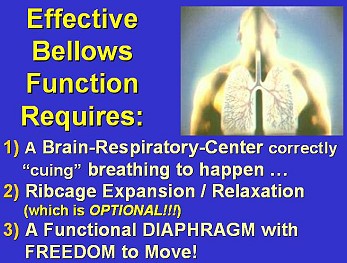
2004 PPt Slide, C.D.Miller
[If the diaphragm is properly functioning, ribcage expansion is not required for “normal” breathing to effectively be accomplished.(12)] AND The ability of the diaphragm (the largest and most IMPORTANT respiratory muscle) to contract and displace abdominal contents downwards/outwards, increasing the size of the interior lung-space, so that inhalation can occur – and the ability of the diaphragm to relax and return to its normal position, decreasing the size of the interior lung-space, so that exhalation can occur.
The ability of the diaphragm (the largest and most IMPORTANT respiratory muscle) to contract and displace abdominal contents downwards/outwards, increasing the size of the interior lung-space, so that inhalation can occur – and the ability of the diaphragm to relax and return to its normal position, decreasing the size of the interior lung-space, so that exhalation can occur.
An EQUAL air-pressure inside and outside of the body results in
airway was open,
but his lung-size
was in a fixed,
unchanging position,
the air-pressure
INSIDE his lungs
would be the SAME
as the air-pressure
OUTSIDE his body.

2004 PPt Slide, C.D.Miller
NO AIR MOVEMENT between these two spaces. NO “breathing.”
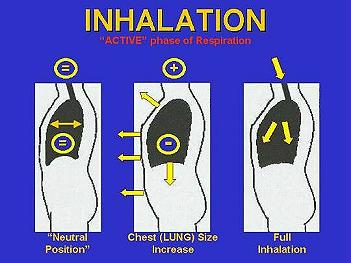
Graphic © 2001, C.D.Miller
 This INCREASES the SIZE of internal lung-space.
This INCREASES the SIZE of internal lung-space.
 Ribcage expansion only slightly increases the size of the chest and internal lung-space. The greatest internal lung-space size increase occurs when the diaphragm contracts and travels down into the abdomen.(12)
Ribcage expansion only slightly increases the size of the chest and internal lung-space. The greatest internal lung-space size increase occurs when the diaphragm contracts and travels down into the abdomen.(12)
 When the airway opens, air moves from the area of higher pressure (the atmosphere) to the area of lesser pressure (the lungs) = air rushes into the lungs, producing INSPIRATION. Air keeps moving into the lungs, continuing inspiration, until the air pressure inside the lungs becomes the SAME as the air pressure in the atmosphere. Once the internal and external air pressures equalize, all air movement stops, and all inspiration stops.
When the airway opens, air moves from the area of higher pressure (the atmosphere) to the area of lesser pressure (the lungs) = air rushes into the lungs, producing INSPIRATION. Air keeps moving into the lungs, continuing inspiration, until the air pressure inside the lungs becomes the SAME as the air pressure in the atmosphere. Once the internal and external air pressures equalize, all air movement stops, and all inspiration stops.
 [Since “active” movement (energy-expenditure) is required to make the internal lung-space LARGER, inspiration is also called the “Active Phase” of respiration.]
[Since “active” movement (energy-expenditure) is required to make the internal lung-space LARGER, inspiration is also called the “Active Phase” of respiration.]
 Relaxation of the ribcage’s intercostal muscles only slightly decreases the size of the chest and its internal lung-space. The greatest lung-space size decrease occurs when the diaphragm relaxes and moves back up out of the abdomen.
Relaxation of the ribcage’s intercostal muscles only slightly decreases the size of the chest and its internal lung-space. The greatest lung-space size decrease occurs when the diaphragm relaxes and moves back up out of the abdomen.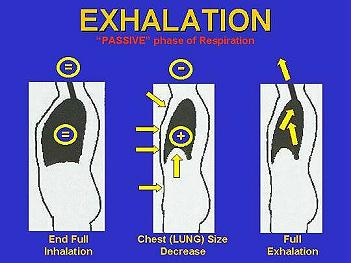
Graphic © 2001, C.D.Miller
 Air keeps moving out of the lungs and into the atmosphere until the air pressure inside the lungs becomes the SAME as the air pressure outside the lungs. Once the internal and external air pressures equalize, all air movement stops, and all expiration stops.
Air keeps moving out of the lungs and into the atmosphere until the air pressure inside the lungs becomes the SAME as the air pressure outside the lungs. Once the internal and external air pressures equalize, all air movement stops, and all expiration stops.
 [Since only relaxation – and no “energy-expenditure” – is required to make the intrathoracic space smaller, expiration is also called the “Passive Phase” of respiration.
[Since only relaxation – and no “energy-expenditure” – is required to make the intrathoracic space smaller, expiration is also called the “Passive Phase” of respiration.
 The muscles used to assist lung-space-size changes when breathing has become difficult include: the muscles between the ribs, neck and shoulder muscles, lateral abdominal muscles, and even the muscles of the arms and legs.
The muscles used to assist lung-space-size changes when breathing has become difficult include: the muscles between the ribs, neck and shoulder muscles, lateral abdominal muscles, and even the muscles of the arms and legs.
 In fact, it is practically impossible for Restrainers to tell the difference between a Victim struggling to “escape restraint,” and a Victim desperately struggling to BREATHE!
In fact, it is practically impossible for Restrainers to tell the difference between a Victim struggling to “escape restraint,” and a Victim desperately struggling to BREATHE!
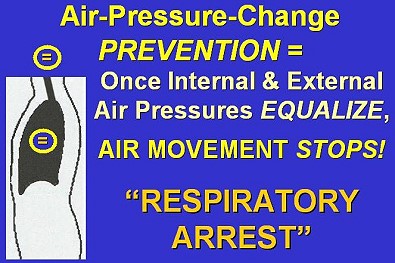
2004 PPt Slide, C.D.Miller
prevented from physically
changing their internal
lung-size and space, entirely
prevented from changing the
air pressure inside their lungs,
breathing cannot occur.
that condition is called,
“RESPIRATORY ARREST.”
RESPIRATORY PHYSIOLOGY
– how NORMAL BREATHING occurs!
 Restraint asphyxia only occurs when an asphyxiating form of restraint is preceded by and associated with lethally-exhausting and body-chemical-unbalancing activities.
Restraint asphyxia only occurs when an asphyxiating form of restraint is preceded by and associated with lethally-exhausting and body-chemical-unbalancing activities.
 But, the lethally-exhausting and body-chemical-unbalancing activities preceding restraint application – by themselves – do not cause death, either. So, the asphyxiating form of restraint remains the ultimate “cause” of death.
But, the lethally-exhausting and body-chemical-unbalancing activities preceding restraint application – by themselves – do not cause death, either. So, the asphyxiating form of restraint remains the ultimate “cause” of death.
PHYSICALLY-EXERTIVE ACTIVITY
have consistently been associated
with restraint asphyxia deaths.
describes these PHASES, and
explains why they place a Victim
at risk for restraint asphyxia. 
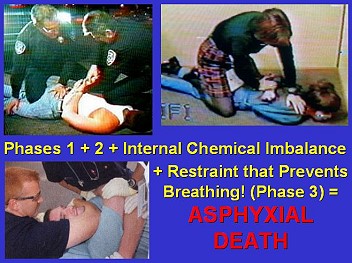
2004 PPt Slide, C.D.Miller
Patient Activities/Behaviors – Preceding Restraint –
That Contribute to Restraint Asphyxia
of RESTRAINT ASPHYXIA – SILENT KILLER
of RESTRAINT ASPHYXIA – SILENT KILLER


 Email Charly at: c-d-miller@neb.rr.com
Email Charly at: c-d-miller@neb.rr.com
Those are hyphens/dashes between the “c” and “d” and “miller”